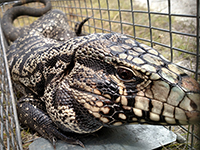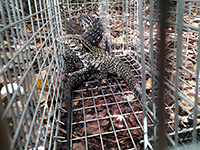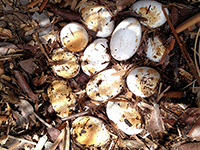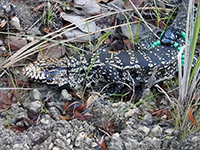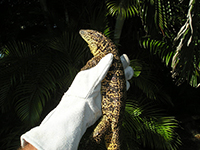Control of invasive tegus in Florida
While pythons have received a majority of public attention, invasive lizards also pose a significant threat to southern Florida's native wildlife and ecosystems. The Argentine black and white tegu (Salvator merianae, previously Tupinambis merianae) has been introduced through the pet trade and has established breeding populations in Hillsborough County, St. Lucie County, Charlotte County, and Miami-Dade County. Argentine black and white tegus are omnivores, eating a variety of plants and small animals, but are especially known for eating buried eggs of reptiles. We have documented tegus eating American alligator (Alligator mississippiensis) and turtle eggs in Florida (See video below). They have been seen using burrows of Gopher tortoises (Gopherus polyphemus) and consume tortoise hatchlings. The growth and spread of tegu populations has the potential to impact populations of threatened and endangered native species, such as American crocodiles, sea turtles, ground nesting birds including the threatened burrowing owl (Athene cunicularia floridana).
The University of Florida research team is collaborating with the Florida Fish and Wildlife Conservation Commission, the National Park Service, the U.S. Geological Survey, the U.S. Fish and Wildlife Service, and the South Florida Water Management District to contain and reduce the tegu population in Miami-Dade and St. Lucie Counties. The Miami-Dade County population is near several vulnerable areas including Biscayne National Park, Crocodile Lake National Wildlife Refuge, and Everglades National Park where the potential for deterioration of valuable ecological systems and species of concern is great. The St. Lucie County population is a recent establishment and efforts to prevent or mitigate the establishment and spread of the population are a priority. This includes:
- Maximizing detection and removal of tegus in occupied areas
- Preventing expansion to new areas (including both public and private lands)
- Evaluating effectiveness of integrated outreach and current trapping programs
- Dissecting and analyzing tegu diet to evaluate impacts
- Analyzing factors that influence body condition as a proxy to assess fitness
- Using radio telemetry to understand how tegus move through the landscape and apply results to enhance removal
Trapping efforts for Argentine black and white tegus produced evidence for an established population of another South American species in Florida, the gold tegu (Tupinambis teguixin). Similar to Argentine black and white tegus, gold tegus are a potential threat to nesting indigenous wildlife because their diet in their native range includes eggs (see publication below).
New Publication(s):
McCaffrey, K.R., Balaguera-Reina, S.A., Falk, B.G., Gati, E.V., Cole, J.M., Mazzotti, F.J. 2023. How to estimate body condition in large lizards? Argentine black and white tegu (Salvator merianae, Duméril and Bibron, 1839) as a case study. Plos one 18(2): e0282093.
Goetz, S.M., Steen, D.A., Miller, M.E., Guyer, C., Kottwitz, J., Roberts, J.F., Blankenship, E., Pearson, P.R., Warner, D.A., Reed, R.N. 2021. Argentine black and white tegu (Salvator merianae) can survive the winter under semi-natural conditions well beyond their current invasive range. PLoS ONE 16(3): e0245877. Full PDF
Meshaka, W.E. Jr., Mazzotti, F.J., Rochford, M.R. 2019. Ecological plasticity and the future of the Argentine giant tegu (Tupinambis merianae Dumeril and Bibron, 1839) in the Southeastern US. Southeastern Naturalist 18(4):659-676. Full PDF
DISCLAIMER: The publisher, Eagle Hill Institute reserves the copyright to all its publications. Any reproduction, other than for an individual's own personal and private use, or distribution of journal content is prohibited without written permission from Eagle Hill Institute.
Images
Fact Sheet
The Argentine Black and White Tegu in South Florida (PDF)
Links
Everglades CISMA - Tegu Lizards
Miami Herald Coverage of UF Tegu Research
Select Publications
Edwards, J.R., Ketterlin, J.K., Rochford, M.R., Irwin, R., Krysko, K.L., Duduesnel, J.G., Mazzotti, F.J., & Reed, R.N. 2017. The Gold Tegu, Tupinambis teguixin (Linnaeus 1758)(Squamata: Teiidae): evidence for an established population in Florida. Bioinvasions Records 6(4): 407-410. Full PDF
Johnson, F.A., B.J. Smith, M. Bonneau, J. Martin, C. Romagosa, F. Mazzotti, H. Waddle, R.N. Reed, J. Ketterlin Eckles, L.J. Vitt. 2017. Expert elicitation, uncertainty, and the value of information in controlling invasive species. Ecological Economics 137: 83-90. Full PDF
Mazzotti, F.J., McEachern, M., Rochford, M.R., Reed, R.N., Ketterlin Eckles, J., Vinci, J., Edwards, J., Wasilewski, J. 2014. Tupinambis merianae as nest predators of crocodilians and turtles in Florida, USA. Biological Invasions DOI 10.1007/s10530-014-0730-1. Full PDF
Pernas, T., Giardina, D.J., McKinley, A., Parns, A., Mazzotti, F.J. 2012. First observations of nesting by the Argentine black and white tegu, Tupinambis merianae in south Florida. Southeastern Naturalist 11(4):765-770. Full PDF
